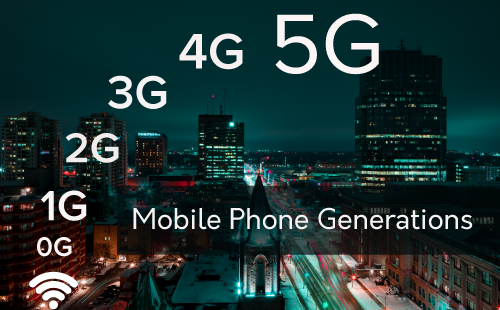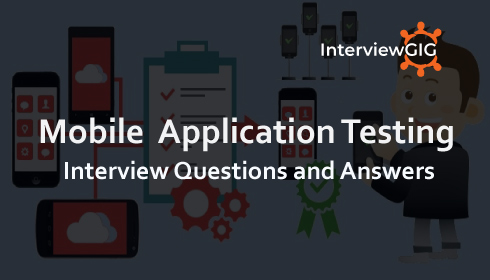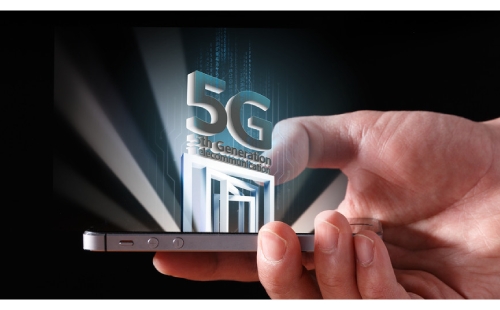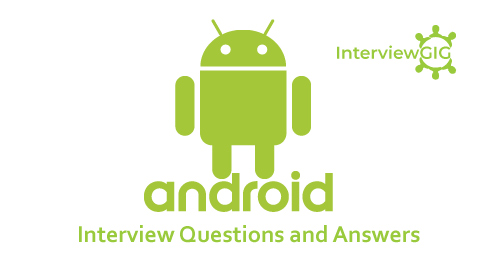Evolution of Mobile Phone generations in telecommunications : 0G, 1G, 2G, 3G, 4G, and 5G
The mobile phone has become an integral part of our daily lives, undergoing numerous revolutions and advancements in mobile networks, spanning from 0G to 5G, over the past two decades. Back in the 1940s, engineers at AT&T pioneered the development of cellular technology for phone base stations. Motorola Company achieved a significant milestone on April 3, 1973, when they introduced the world’s first handheld mobile phone. Since then, the evolution of mobile phone networks has witnessed remarkable progress and innovation.

0G Mobile Phones or Zero Generation(0G)
The origins of wireless telephony can be traced back to the advent of 0G technology. Developed in the 1970s, 0G represents the precursor to cellular mobile telephony as we know it today. It was through the mobile radio telephonic system that the foundation for modern cellular technology was established, earning the moniker of 0G or Zero Generation systems.
One of the pioneering milestones occurred in 1971 when ARP (Autoradiopuhelin) launched the first public commercial mobile phone network in Finland. This marked a significant step towards the widespread adoption of mobile communication worldwide.
There are different technologies used in 0g systems:
PTT (Push to Talk)
MTS (Mobile telephone system)
IMTS (Improved Mobile Telephone Service)
AMTS (Advanced Mobile Telephone system)
OLT (Norwegian for Offentlig Land Mobil Telefoni)
PLMT (Public Land Mobile Telephony)
MTD (Mobile Telephony system D)
1G Mobile Phones 0r First Generation(1G)
The advent of 1G technology marked the introduction of the first-generation wireless telephone systems in the 1980s. These early mobile phones were primarily designed for analog voice communication. In the USA, the Advanced Mobile Phone System (AMPS) was launched as the standard for 1G in 1982, operating within a bandwidth of 40MHz and a frequency range of 800 to 900MHz. The data speeds of 1G analog mobile phones ranged from 2.4kbps to 9.6 to 28kbps.
Initially, these mobile phones were large and intended for installation in vehicles, earning them the name “car phones.” However, as mobile telephony gained popularity in the 1980s, mobile phones began to transition towards smaller, more portable designs that relied on cellular networks or cell systems. This shift contributed to the increasing accessibility and widespread use of mobile phones during that era.
2G Mobile Phones 0r First Generation(2G)
The emergence of 2G (GSM – Group Special Mobile) technology marked the advent of the second generation of wireless mobile phone technology in the early 1990s. This digital technology revolutionized communication. The first 2G network was launched by Radiolinia in Finland in 1991, operating on the GSM standard. It introduced features like text messaging (SMS) and multimedia messaging service (MMS), enabling data transmission.
The most prevalent 2G technology was the GSM system based on Time Division Multiple Access (TDMA). Initially popularized in Europe, it gained widespread adoption worldwide, excluding North America. Operating on the 900 to 1800 MHz network band, 2G offered circuit-switched data with speeds reaching up to 14.4kbps.
2.5G (GPRS-General Packet Radio server):The evolution continued with 2.5G, known as GPRS (General Packet Radio Service). Positioned between 2G and its successor, 3G, GPRS enhanced data transmission capabilities. It facilitated services such as WAP access, MMS, and internet communication services like email and WWW access, offering data rates ranging from 56kbps up to 115kbps.
2.75G (EDGE- Enhanced Data rates for GSM Evolution):Building upon GSM, 2.75G arrived in the form of EDGE (Enhanced Data Rates for GSM Evolution). This technology represented an extended version of GSM, enabling clear and rapid data transmission at speeds of up to 384kbps. EDGE played a crucial role in facilitating faster and more efficient data communication for mobile phone users.
3G Mobile Phones or Third Generation(3G)
3G(UMTS and CDMA and HSMA) is the third generation of wireless mobile phone standards and technology. The first 3G networks were introduced in 1998. In the mid 2000s an evolution of 3G technology begun to be implemented, namely HSDPA (High-Speed Downlink Packet Access). The predominant 3G technologies on the GSM side are WCDMA and HSDPA with CDMA2000 on the CDMA side. It enables Enhanced audio and video streaming, higher data speed, Video conversing support, web and WAP browsing at higher speed, IPTV support.
3.5G (HSDPA -High-Speed Downlink Packet Access): HSDPA is a packet-based data service in W-CDMA downlink with data transmission up to 8-10 Mbps (and 20 Mbps for MIMO systems) over a 5MHz bandwidth in WCDMA downlink.
3.75G (HSUPA -High-Speed Uplink Packet Access): HSUPA will enhance advanced person-to-person data applications with higher and symmetric data rates, like mobile e-mail and real-time person-to person gaming. HSUPA will initially boost the UMTS / WCDMA uplink up to 1.4Mbps and in later releases up to 5.8Mbps. Current HSDPA deployments support down-link speeds of 1.8, 3.6, 7.2 and 14.0Mbps. Further speed increases are available with HSPA+, which provides speeds of up to 42 Mbps downlink and 84 Mbps with Release 9 of the 3GPP standards.
(Bandwidth: 5-20MHz)(Frequency-1800 2400MHz)
4G Mobile Phones or Fourth Generation(4G)
4G is the fourth generation of wireless mobile phones or broadband cellular network technology. It was released in 2008.4G LTE Starting in the 2011 time frame, GSM and CDMA carriers embraced LTE, which offers higher speeds than 3G networks. It supports mobile web access like 3G but also gaming services, HD mobile TV, video conferencing, 3D TV, and other things that demand higher speeds.
4G (OFDMA / SC-FDMA): The introduction of 4G (OFDMA/SC-FDMA) technology brought significant advancements to mobile networks. Operating across various frequencies such as 700MHz, 850MHz, 1800MHz, 1900MHz, 2100MHz, 2300MHz, and 2600MHz, along with higher frequency bands in the range of 2-8 GHz, 4G networks offered increased bandwidth of up to 100MHz.
4G LTE: 4G LTE (Long-Term Evolution) networks enabled remarkable data transfer speeds, reaching peak download speeds of up to 100Mbps and peak upload speeds of 50Mbps. This enhancement in speed revolutionized mobile internet connectivity.
4G WIMAX (IEEE 802.16m): Another variant of 4G, known as 4G WiMAX (IEEE 802.16m), provided even higher data transfer speeds. With peak download speeds of 128Kbps and peak upload speeds of 56Mbps, WiMAX offered improved performance and connectivity options.
4G LTE Advanced: The evolution of 4G continued with 4G LTE Advanced, which pushed the boundaries of data transfer speeds even further. With peak download speeds of up to 1000Mbps and peak upload speeds of 500Mbps, LTE Advanced brought unprecedented levels of speed and efficiency to mobile networks.
These impressive speed improvements in 4G were made possible by employing Orthogonal Frequency Division Multiplexing (OFDM) technology. OFDM, also utilized in various other transmission systems such as ADSL, Wi-Fi, DVB-T, DVB-H, and DAB, played a pivotal role in delivering faster and more reliable data transmission over 4G networks.
5G Mobile Phones or Fifth Generation(5G)
5G networks were already being deployed and launched in various countries around the world. The exact launch dates for 5G networks can vary depending on the region and the specific service providers. Many countries started rolling out 5G networks in 2019 and 2020, and the deployment has continued since then. It is advisable to refer to local telecommunication authorities or service providers in your specific region for the most up-to-date information on the availability of 5G networks.
5G technology is built upon the foundation of the 802.11ac IEEE wireless networking standard. Its development focuses on achieving lower latency, reduced costs, and improved battery consumption compared to previous generations. Additionally, 5G offers significantly faster data transmission speeds, surpassing those of its predecessors. This enhanced speed and performance enable a wide range of applications, including Internet of Things (IoT) services for businesses, smart cities, connected cars, and ubiquitous healthcare.
One of the key elements of 5G is its utilization of high-frequency bands, commonly referred to as the Millimeter Wave Spectrum or Extremely High Frequency. These frequencies typically range from 28 GHz to 39 GHz. By utilizing this spectrum, which falls within the 30 GHz to 300 GHz range, 5G networks are capable of delivering the high speeds required for advanced connectivity and data transfer.
See More: What is 5G Technology
The FCC is announcing new rules for high frequency (over 24 GHz) wireless broadband operations and opening almost 11 GHz of high-frequency spectrum for mobile and fixed use wireless broadband.
Specifically, some of this is being made available in the licensed bands: 28 GHz (27.5-28.35 GHz), 37 GHz (37-38.6 GHz), and 39 GHz (38.6-40 GHz) bands, but of particular relevance is a new unlicensed band at 64- 71 GHz – which effectively extends the unlicensed 60GHz band (which 802.11ad broadband, aka WiGig, uses).
6G Technology?
6G technology was still in the early research and development stages, and there were no widely adopted standards or specifications for it. However, the concept of 6G technology has been discussed as the potential successor to 5G, aiming to further enhance wireless communication capabilities and meet future connectivity needs.
While specific details about 6G are still uncertain, some potential key features and goals have been proposed. These include even faster data speeds, lower latency, higher capacity, improved energy efficiency, enhanced reliability, and support for advanced technologies such as artificial intelligence (AI), virtual reality (VR), and augmented reality (AR). 6G is also expected to address emerging use cases and requirements, such as massive IoT connectivity, ultra-reliable and low-latency communication (URLLC), and seamless connectivity in various environments.
It’s important to note that the development and standardization of 6G technology will likely take several years, and its deployment is expected to be in the 2030s or later. Ongoing research, international collaborations, and technological advancements will shape the future landscape of 6G technology.





